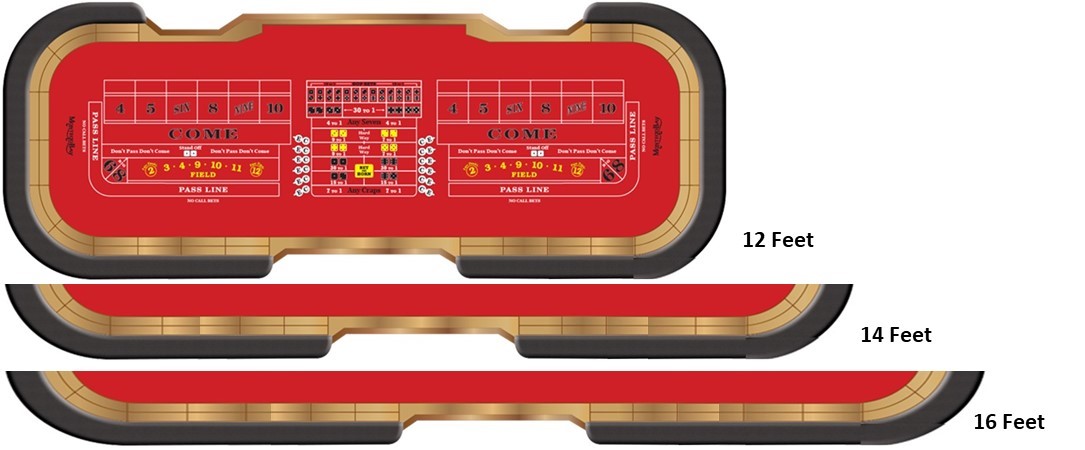If you’ve reached this point in your development as a Controlled Shooter, then you understand that even slight variations in your grip, backspin, alignment, etc., will result in potentially dramatic differences in the results you achieve.
Unfortunately, I had to learn the hard way, that the table position you select can also have a dramatic impact on the success of your controlled throws.
LET ME EXPLAIN
After practicing a controlled toss for several months, I had gotten to the point where my dice were symmetrically traveling through the air with a controlled backspin, the dice were landing softly on my target zone, touching the diamonds lightly and I was achieving pretty solid results staying on-axis and avoiding the seven.
While I realized there was still a lot of work to do in perfecting my throw, it was time to bring my newly learned skill to the casino and try it out.
Most dice coaches recommend that, depending on your toss style, you select either spot #1 or #2 to the right or left of the stick at the craps table. By selecting either the #1 or #2 spot, it gives you a much shorter distance to backwall with the thought that, the less distance you deal with, the more control you will have with the dice.
There is a lot of merit to that thought process, and since I was tossing right to left, I selected ‘R1’ and waited my turn with the dice. When the dice were slid to me, I quickly set them, gripped and tossed just like I had practiced.
Instead of landing softly and lightly touching the diamonds, my dice were hitting the target zone squarely, but then launching into the diamonds which caused the dice to scatter all over the table and produce completely random results.
Extremely disappointed, I went back to my practice layout, tossed the dice, and everything seemed to work fine. Disappointment turned to confusion and it wasn’t until two days later that the solution dawned on me.
The craps table at the casino was a 12 foot table, which means the inside of the table, after accounting for the rails, is just over 11 feet. The stick then, is at 5 ½ feet, so I was throwing from about 6 ½ feet. When I checked my practice area, I was practicing from just over 8 feet. The extra 1 ½ feet in my practice area required more energy to deliver the dice to the backwall than at the casino. That additional energy in my throw caused the dice to launch into the diamonds instead touching them lightly on the shorter table.
A VERY DIFFERENT APPROACH TO TABLE POSITION
I now personally use, and coach others, on a very different approach to table position than the general advice that’s out there. It still involves keeping the distance of your throw as short as possible to maintain the greatest level of control, but it eliminates the need to alter your throw from table to table.
While you can find smaller tables, most craps tables are 12 or 14 feet long, and you’re now beginning to see some 16 foot craps tables is some casinos.

As you can see from the tables above, there is a big difference in the ‘R1’ or ‘L1’ distance between 12, 14 and 16 foot tables.
Every craps table at the casino has its own variables you’ll need to account for and potentially adjust your toss for;
- Bounciness of the table
- Type of cloth used on the table top
- Hardness of the back wall diamonds, and
- Sharpness of the dice edges
KEYS TO SUCCESS
Our goal is to eliminate distance as a variable and allow you to focus on the slight variations needed for the above conditions.
- Research the casinos that you’ll be playing at, and what size tables they have
- Ex: You play at 3 casinos that employ both 12 and 14 foot craps tables
- Identify the shortest table position that accommodates the craps tables you’ll play
- In the example above, using 12 and 14 foot tables, ‘R1’ and ‘L1’ on the 14 foot table would accommodate both
- Set up your practice area to mimic the distance you’ve determined in step #2
- A 14 foot table is approximately 13 feet from rubber to rubber
- The stick would then be approximately at 6 ½ feet
- ‘R1’ and ‘L1’ would be approximately 7 ½ to 8 feet from the opposite diamonds
- Set your practice area to toss from 7 ½ to 8 feet from your landing zone
- Regardless of the length of the craps table at the casino, position yourself 7 ½ to 8 feet from the opposite diamonds
- On a 14 foot table, that will be ‘R1’ or ‘L1’
- Ona 12 foot table, that will likely be ‘R2’ or ‘L2’
In the above example, if your preferred position is at the ends of the tables, then you’ll need to set up practice distances of both 11 and 13 feet to accommodate both.
You should find this as helpful as our students have, at creating parity and consistency between your ‘at home’ practice sessions and the live conditions at the casino.
For more information on becoming a Controlled Shooter and flipping the odds on the casino, check out…
.

Craps Secrets has merged with the Black Chip Club
Please visit us at BlackChipClub.com
.
*****************
If you have any questions, suggestions or recommendations, feel free to leave them in the comments section below.
In the meantime…
BEST OF LUCK AT THE CASINOS!!!



11 thoughts on “Craps: Controlled Shooter Table Position”